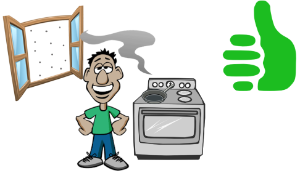- Created by Juan Pedro Maestre, last modified on Jul 24, 2019
Studies suggests that even the simple act of cooking can pollute the indoor air leading to adverse health effects.
By: David Jarma
May 2019
We’ve all been there. You’re cooking something up on the stove and it starts to get smoky. This can happen for various reasons, but a common cause of a smoky kitchen is simply overheating an oil! A veteran cook knows and understands his oils well and tries to avoid heating above or even reaching the smoke point due to the off tastes this may produce in the food. However, there is another, more serious consequence of reaching the smoke point of any oil. In 2018, Zhao et al. showed that cooking with oil at any temperature releases what is known as particulate matter into the air at a given rate, regardless of the oil. This is an unavoidable truth. Particulate matter are the microscopic particles that exist in the air. Because of this existence, we subsequently breathe it in on a regular basis, and it can end up in our airways and lungs.
In the study mentioned above, oils were kept at a reasonable temperature, about 140 C, well below the smoke point of any common oil, and the generation of particulate matter was observed. In our most recent study, we investigated the consequences of cooking with oil near and even above its smoke point. It was observed that when an oil reaches its smoke point it begins to produce this particulate matter at an increased rate, subsequently introducing more particulate matter into your kitchen air. Just like most other air pollutants, inhaling excessive amounts of particulate matter can have adverse health effects and has been linked to many respiratory and pulmonary diseases and even premature death.
Torkmahalleh et al. observed in 2012 that heating various oils above their smoke points can generate particulate matter equivalent to 1 cigarette per hour. You may be thinking “Oh, but I don’t cook for an hour,” but the problem still stands. With a lack of airflow, the particulate matter has nowhere to go, and therefore lingers inside your living space. It decreases over time, yes, but ever so slowly. Although this source of indoor pollution originates from our food, it can still be just as harmful to our health. Inhaling it at the same rate as a cigarette per hour is sure to be alarming and raises the question, “how can we reduce the amount of particulate matter in our air?”
This may be a lot to take in at once (or shall I say inhale at once?), but fret not, there are a couple quick fixes that can significantly reduce the concentration of this particulate matter in your air and lungs. The first option, and probably what people think of first when cooking, is to turn on a vent hood. Conceptually, this works, especially if said vent hood actually vents to the outside, essentially taking the dirty air and throwing it outside. Unfortunately, in residential kitchens it seems far more common to just have a microwave vent fan as the vent hood. Microwave fans may filter out some of the particulate matter, but in the end it just recirculates the air, recycling it back into your airspace and never truly exhausting it to the outside. Given that the outdoor air is clean, in the US it it could be said that it generally is (check it out real time here), but it really depends on your location, time of the year, even time of the day(!), an even better solution than an externally vented hood, is to open a couple windows. While one window may be effective, multiple windows will really ramp up the rate at which particulate matter leaves your home. The reasoning is as simple as the breeze; outdoor air comes in one window and effectively pushes or carries the old, dirty, stuffy air from inside back out the other window. What you have left is clean outdoor air which, again, generally has a much lower amount of particulate matter, and a happy healthy living environment.
Next time you’re cooking, and your food starts smoking, instead of reaching for the vent fan (after you’ve lowered the heat of the oil, of course), consider opening up a few windows and enjoying a breath of fresh air.
PS: if you live in an area with frequent high particulate matter concentrations, you may want to purchase a good indoor air purifier.


- No labels